Hugeasscityscapes Vol. 2, Scene 2
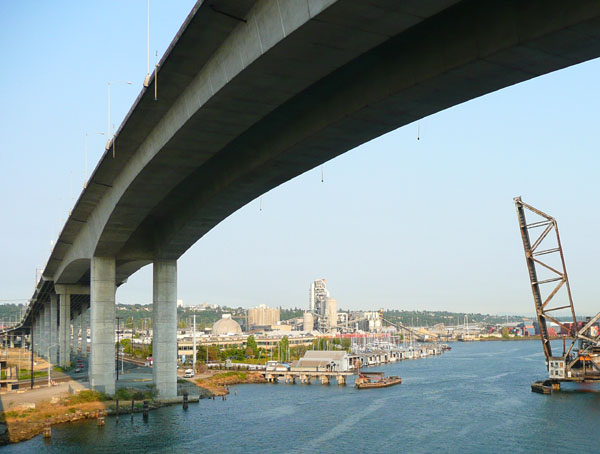
[ The West Seattle Bridge ]
(Editor’s note: In the comments on Cary Moon’s tunnel post there was much discussion about options for transit service and McGinn’s proposal for light rail to West Seattle, and Joel Horn, former executive director of the Seattle Monorail Project, was asked to weigh in these questions: So what options ARE technically viable for better mass transit to the west side? And what would have to change politically for transit that requires taking a car lane to succeed—like a true BRT system or light-rail?)
First off, I want to start by acknowledging that many good folks have worked on this for quite a few years. And this isn’t the venue for a voluminous thesis, but there are a few points that I will make to continue the discussion:
1)Â The quickest and least expensive way to add high capacity transit to West Seattle is to use the West Seattle Bridge (WSB). The Seattle Monorail Project (SMP) worked with a number of the world’s best engineers and construction companies, and with the City engineers, to determine the load carrying capacity of the WSB. SMP also worked with SDOT and had many public workshops about how to add high capacity transit and not remove any traffic lanes. The best way to achieve that is to use the airspace above the bridge. This airspace is a public resource that has significant capacity for grade-separated transit. There was a limitation as to how much weight can be added to the WSB. I do not know if it could handle the weight of an elevated light rail solution similar to the elevated system that Sound Transit is using to go to the airport.
2)Â When SMP was coordinating its construction schedule with other major projects downtown we were instructed that Sound Transit would get first priority to complete light rail in the 3rd Avenue bus tunnel. Then the Green Line would be built on 2nd Avenue and then the viaduct would be taken down. SMP ran their ridership model to determine the potential impact on the Green Line during the period that the viaduct was not available. The model showed that SMP would need to add 4 additional trains to the Green Line to accommodate the additional ridership (running every 6 minutes to West Seattle). One of the relevant pieces of information from this ridership analysis was how many people would give up their cars and switch to the Monorail. The question was what would happen when the car capacity was replaced. At the time ridership experts advised the SMP that much of the ridership would permanently switch to mass transit, thereby reducing the need for capacity replacement with the viaduct project.
3)Â One additional piece of information that came out of the ridership studies was that there is excess capacity on the downtown streets today. This is easy to observe if you go downtown on a “normal” day i.e. no construction and no Mariners game. The street system works well and can absorb additional demand for travel. In fact, even though the Monorail Green Line would have taken out a lane on 2nd Avenue there was still adequate capacity to handle the existing load. Ridership studies involve many variables and can be manipulated to make an argument for one alternative or another, but it was clear during the SMP analysis that taking a lane out of 2nd Avenue would not have an adverse impact on Downtown traffic if the lane was used for a transit solution that would actually be competitive enough (time savings by using grade separated transit and money saved by not needing to pay for parking) to get people to give up their car.
There are many additional topics to add to the mix, and these are only starting points to consider when thinking about how to best serve West Seattle with transit.
As has just been reported at Publicola, Elizabeth Campbell and The Citizens Against the Tunnel filed a lawsuit today to stop the deep-bore tunnel. Check out the gory details here (3 MB pdf). Campbell’s group supports a new elevated solution to replace the Alaskan Way Viaduct, but that is irrelevant to the case being made against the tunnel. Interestinger and interestinger.
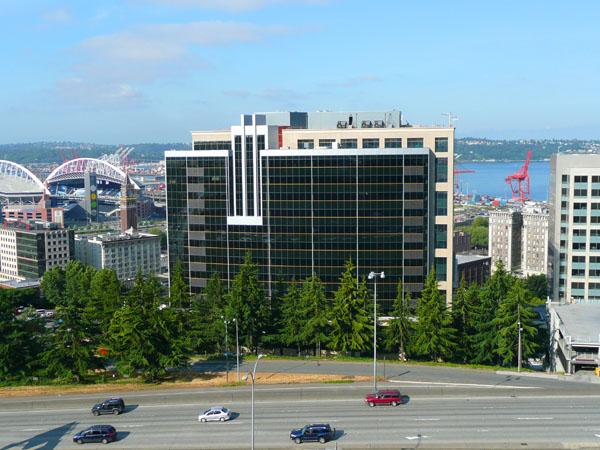
[ 5th & Yesler ]
In case you hadn’t heard:
Commercial real estate is the “second shoe” to drop in hurting the economy…
In Seattle, the office vacancy rate has hit 18.5 percent, and commercial real estate sales are at a 20-year low. Seattle recently shot up to number one on the list of U.S. cities with the highest rates of troubled real estate loans.
Right on cue, several large office projects are nearing completion or have recently come on line in Seattle:
Business cycles are us. When the object of the game is to make the most money with the least amount of effort possible, speculation will always be irresistable. And that would be just fine and dandy but for one pesky detail: deep economic cycles seriously fuck with people’s lives.Â

[ 2201 Westlake ]
>>>

[ 7th & Madison ]
>>>

[ 1918 8th Ave (under the crane) and 2001 8th Ave (just to right of crane) ]

Whence cometh the ice cream trucks of summer,
And whither goest they,
When the cold rains of winter fall?
No really. Do they migrate south? Seattle’s ten-month-long winter can’t be so good for business.
Such an odd, yet remarkably persistent commercial enterprise. Many of the trucks and jeeps look like the same ones I chased down growing up in a suburban Boston subdivision. The ice cream truck people are like Cubans in how resourceful they must be to keep those clunkers running. And that scratchy, warbly music blaring from cold war-era loudspeakers, so instantly recognizable by young and old alike.
But then, who are these ice cream truck people who dole out all that industrial ice cream product to our precious children? I suspect most parents find themselves feeling at least a minor, temporary flash of paranoia about pedophiles as they eye the mysterious countenance taking their money.
In Seattle, the ice cream truck people are largely self-employed. Anyone with a driver’s license can have a go at it, though not surprisingly, during this past recession-baked summer, the supply of drivers outstripped demand for product. And if you ever wondered where all that product comes from—Safeway? Costco?—the power of the free market has seen to it that there are dedicated distributors, such as Georgetown’s Mel-O-Dee Ice Cream that supplies over 200 drivers.
Which raises another curiosity: Why haven’t the usual “free-market” forces resulted in domination of the ice cream truck business by corporate chains? You’d think that by now there would be a fleet of shiny green and white Starbucks ice cream trucks hitting the park and playground circuit every summer.
And hey, this is Seattle, so what the hell is taking so long for someone to propose a green ice cream truck business? Local, organic ice cream from Molly Moon’s. Biodiesel trucks with rooftop photovoltaic panels that power the on-board refrigerators. You heard it here first: this is a service for which Seattle’s Keen-wearing, Maclaren stroller-pushing parent demographic is eager to pay a premium. Even though any normal kid would much rather have a artificial-coloring-drenched Bomb Pop.
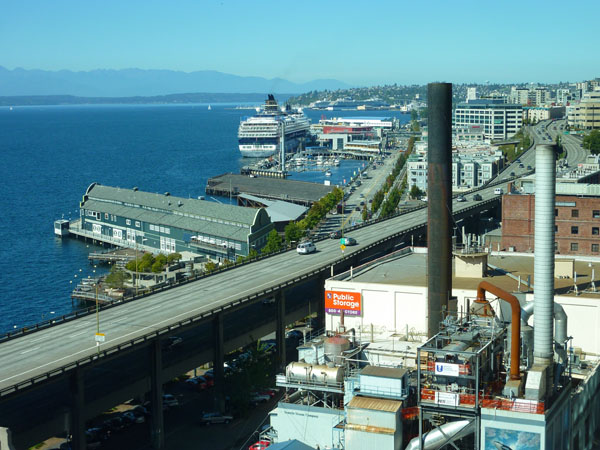
Head spinning from all the conflicting stories around the tunnel proposal and Surface/Transit/I-5 in this campaign season? Here’s a record-straightening summary of what has gone on in the recent nine months and where we are now. Some very big problems are emerging for Seattle in this deal. Whatever you thought in January, you should be paying attention now.
Recap: the January 2009 deal
In January, Gregoire, Sims, and Nickels agreed to jointly fund and build a $4.2 billion package: a bored tunnel, new transit service, a waterfront street and seawall repairs, and other street improvements. Current status:
The underground bypass tunnel: how’s it coming along?
Planning, design, and EIS analysis are underway now. The costs, overrun risks, construction challenges, and environmental impacts have not yet been determined nor explained to the public. Without this crucial information, there is no ‘decision’ yet, much less a done deal.
Â
A non-highway solution: does it work?
At the end of the stakeholder process in December 2008, the three DOTs put forth two recommendations: Surface/Transit/I-5 or an Elevated. (The bored tunnel was not recommended.) The S/T/5 solution is a set of projects to improve through-put on I-5, better connect the street grid, add new transit and incentives to inspire non-car choices, improve options for freight, and build an urban street on the waterfront.
The tunnel plan emerged in January as a fragile political compromise, balancing what the State’s elected leaders think is important (maintaining their state highways, providing capacity for car trips bypassing Seattle, giving Boeing what they want) and what Seattle and King County leaders think is important (providing local mobility and access, freeing the waterfront, supporting local economic growth).
There are bigger issues at stake for our city, though. What kind of transportation system fits future Seattle? What investments should we make now to transition to a future with 50 percent fewer vehicle-miles traveled by 2050 to reduce the emissions that cause climate change, as mandated by the State? Can we even afford a $4.2 billion megaproject?
Across the world, many leading cities are making big changes in their transportation systems to prepare for a different future—New York, London, Paris, Seoul, Copenhagen, San Francisco. Together, their successes show that it’s possible to relieve congestion, create beloved vibrant streets, grow the economy, AND cut greenhouse gas emissions through aggressively improving alternative choices, prioritizing freight, and decreasing car capacity. We should measure twice before we cut: building car capacity we may not need, at this high cost and risk, may turn out to be a terrible investment.
Many Seattleites (myself included) believe the tunnel plan is already a bad deal for Seattle. The situation could get worse, if this megaproject runs into trouble like 90 percent of them do. We better elect a Mayor—and City Council members—who have the intelligence to see what is happening and the courage to fight for Seattle’s best interests when things get rocky.
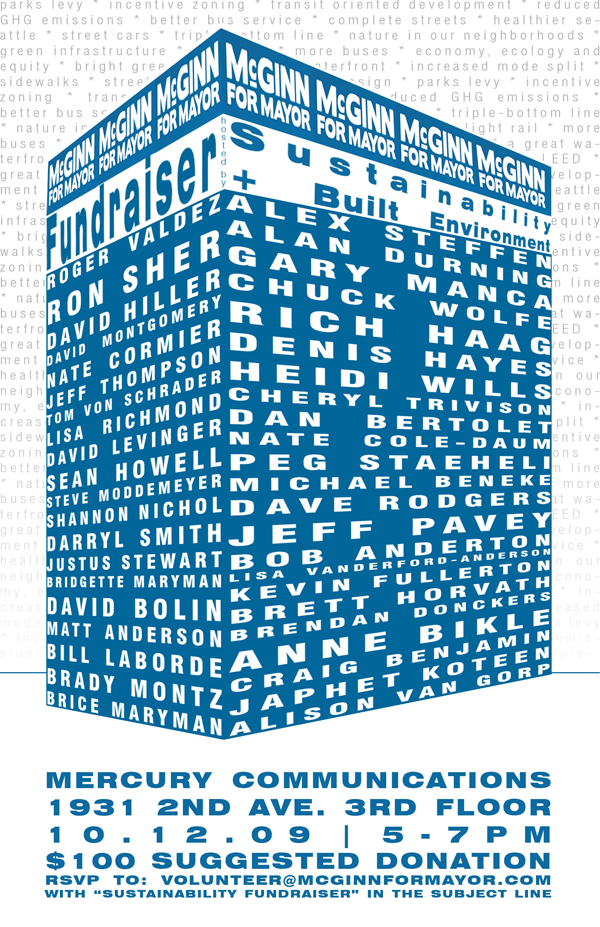
Gaylord Nelson’s statement is a powerful standard by which to assess politics, and a revealing litmus test to apply to Seattle’s upcoming mayoral election. I don’t think it’s a stretch to concede that Joe Mallahan is aligning himself with interests that have it the wrong way around, while Mike McGinn’s core support comes from those who think like Nelson.
Seattle’s status-quo business establishment is lining up behind Mallahan—nuff said. Mallahan has also bagged the support of labor, but why? In large part because some union workers stand to make a pile of money building the deep-bore tunnel. A quintessential example of putting short term economic gain before long term ecological health.
Some worry that McGinn is too antagonistic (or something), and who knows, he could turn out to be a total disaster as Mayor. But one thing we can be sure of is that he understands and respects big picture sustainability, and that he will push hard for the kind of substantive change that reality increasingly demands.  It all starts with a strong vision.
To those who share McGinn’s values but are all caught up in hand-wringing over his possible flaws, a humble suggestion: Let go of your liberal instinct for equivocation and take a gamble. Make a choice and commit to it.
Which, coincidentally, brings me to the point of this post, that being, if you support Mike McGinn for Mayor, please consider actualizing your commitment by attending the upcoming Sustainability and Built Environment Fundraiser (details above). McGinn is up a against a wall of money, and his campaign depends on small, individual contributions.
BONUS: For all you navel gazers who want to know which green urbanist rock stars you may be lucky enough to catch a glimpse of at the fundraiser, you’ll probably want to get on over to facebook and start obsessively tracking the event’s guest list.
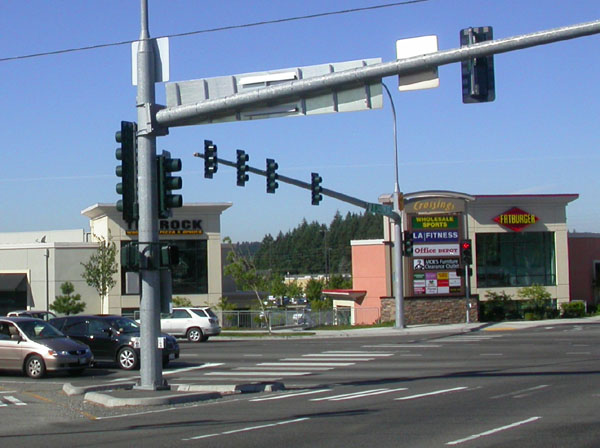
Done did the Puyallup and saw much. The transition out of the Seattle bubble couldn’t be any more dramatic than when I-5 dumps you out on Federal Way’s Enchanted Parkway—shown above—and yes, that’s a Fatburger right next door to LA Fitness.
>>>
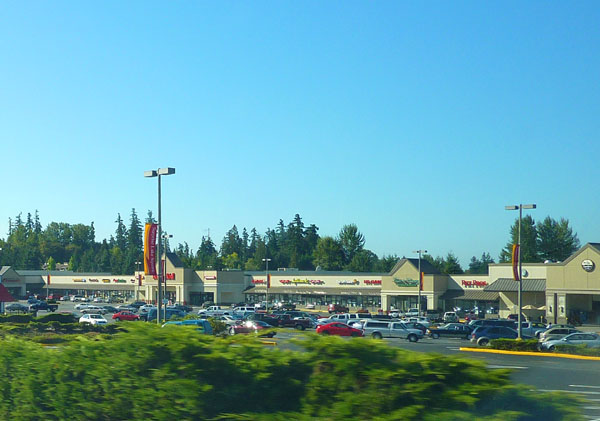
A few miles further south on S.R. 161 in Milton—when will we stop building stuff like this?
>>>
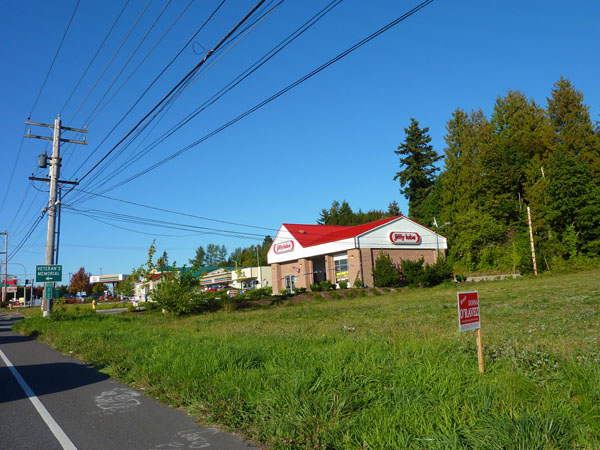
And this.
>>>
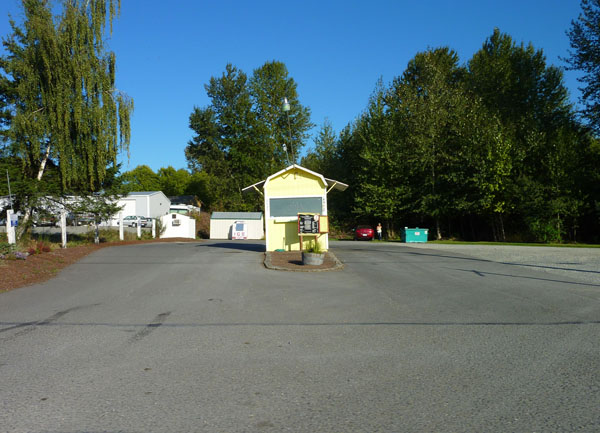
Drive-thru espresso—American ingenuity at its finest.
>>>
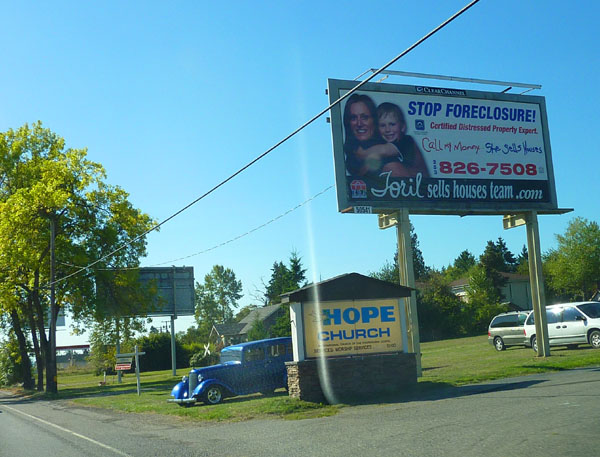
Hope and pray for no foreclosure.
>>>
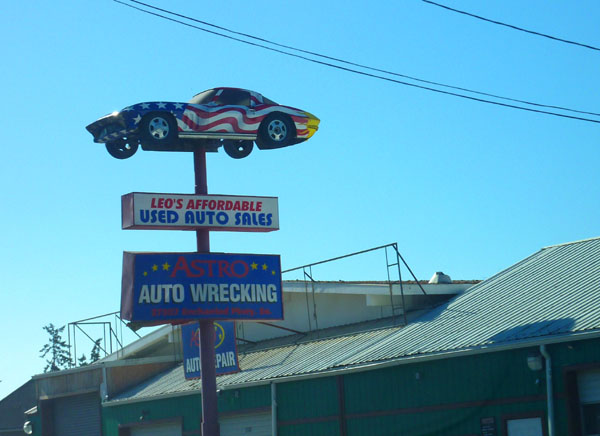
On a pedestal, where it belongs.
>>>

Will the jet builder fare better than the car builder?
>>>
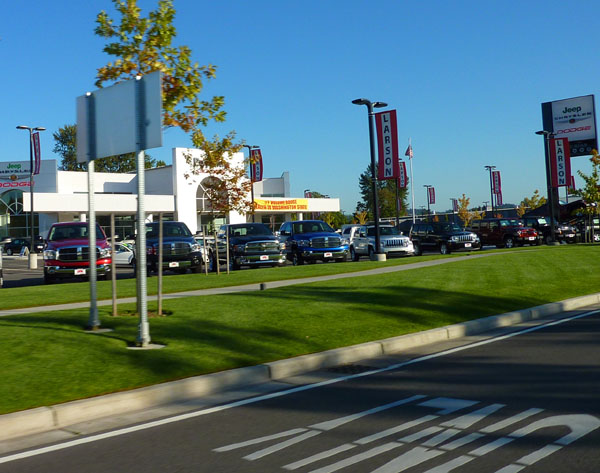
Another crisp, fresh auto dealership denies the future.
>>>

A house in Puyallup.
>>>

A church in Puyallup.
>>>
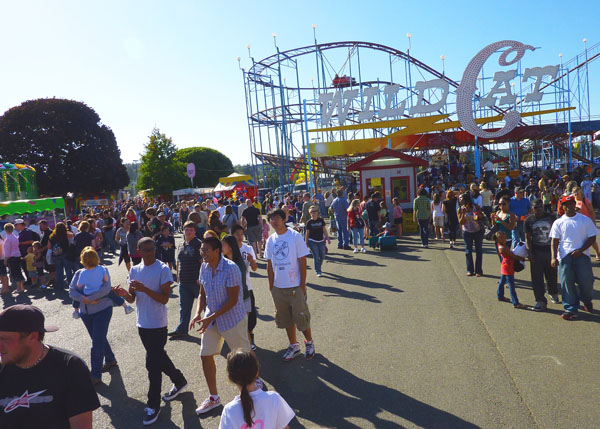
Inside the gates, oh, the humanity. First of all, can someone please explain why carnies have such awful teeth? And apparently I didn’t get several memos, like the one about how the body-piercers and the Seahawks-shirt-wearers have merged into the same tribe.
On the other hand, the sea of people testified to how some things never change:Â teenage girls will always feel the need to plaster their faces with makeup; the black heavy metal concert tee will never—NEVER—go out of style; Huey Lewis and the News will be relevant forever.
In one of the livestock barns (the best part of the Fair) I overheard a woman telling the story of the big grey horse in the stall behind her, how it was going to be sent to the slaughterhouse but at the eleventh hour somebody called somebody who called her daughter, who then begged to be allowed to take the horse, and they did, and the horse was delivered on none other than Christmas Day, and it was so malnourished they could see every vertebra and rib, but they nursed it back to health and here was that same horse today, an award winner. That’s America.
>>>
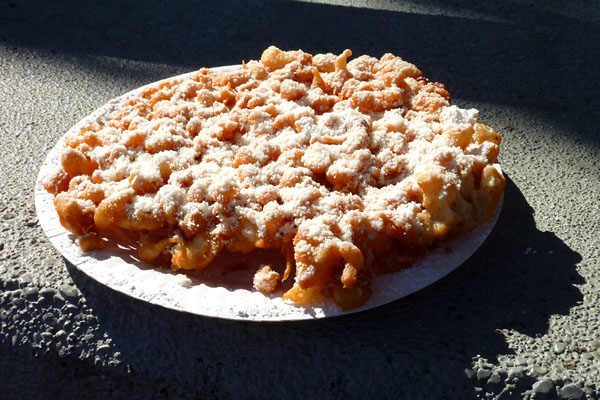
And lastly, a little culinary tease for y’all, a carnival specialty: funnel cake.  The stomach says no but the tongue says yes. Perhaps this has something to do with the carnie teeth woes.
When I saw this headline:
Stable temps could chill work on climate treaty
on the front page of Wednesday’s Seattle Times I immediately assumed is was shoddy climate change reporting reflecting that paper’s ideological leanings. But no, turns out it was originally published by the New York Times and written by their top climate change reporter Andrew Revkin.
Over at Climate Progress, Joe Romm calls the piece the worst of Revkin’s career, and proceeds to thoroughly shred all the claims that form the whole premise, for example that “global temperatures have been relatively stable for a decade,” etc, etc. The two plots below say it all.
How reassuring that our newspaper of record could get it so wrong on climate change. Â Perhaps they’re trying to outdo their performance on the run up to the Iraq War.
>>>

>>>

*Thank you Steven Jesse Bernstein
Sightline has a post up on land use patterns and greenhouse gas (GHG) emissions that makes my day cause it saves me the trouble of writing the same piece.  Some argue that restructuring our built environment to be more compact and location efficient is not a practical strategy for cutting GHGs because it is expensive and will take too long, not to mention being counter to the mythical American way of life. Clark lists five reasons not to buy that argument, and concludes:
In the end, then, I see the fatalistic view of land use—essentially, that changing land use is just too hard—as not merely unhelpful, but unethical. Rather than bemoan how hard it is to make progress, I’d rather buckle down and get to work.
Yes, unethical:Â it needs to be said again and again.
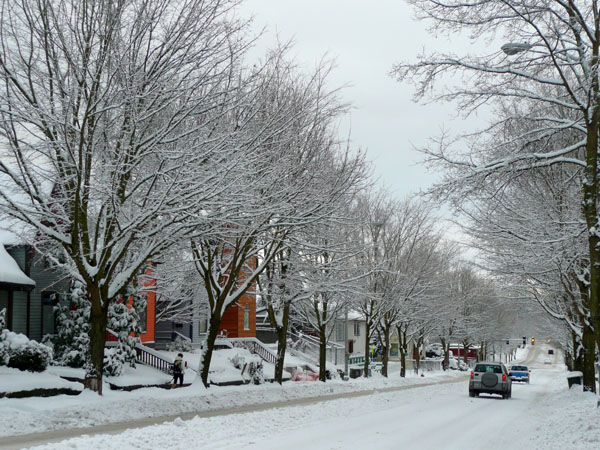
[ The horrors of Snowpocalypse 2008 ]
One of the smartest decisions the next mayor of Seattle could make would be to retain Grace Crunican as the director of the Seattle Department of Transportation. But sadly no, both Mallahan and McGinn have said said they would not. Given Crunican’s record, it’s hard not to interpret that positition as pandering.
Since being appointed by Mayor Nickels in 2002, Crunican has completely transformed the heart and soul of SDOT. What had been an inflexible, close-minded, car-centric, typical American big city transportation department, has been reborn as an agency that embraces the concept of “complete streets;” that produced the bicycle and pedestrian master plans; that delivered Seattle’s first modern age street car; that has been dedicating significant resources to slowly but surely chipping away at the task of improving infrastructure for non-motorized transportation.
Crunican has been consistently pushing for a two-way boulevard to fix the “Mercer Mess,” a proposal that sends the “all developers are evil” crowd into convulsions. But when you have urban designers, transportation engineers, and bike/ped advocates all agreeing, you can be pretty sure you’re on to something good. All indications are that Crunican would also promote a balanced solution for the waterfront after the viaduct comes down.
Crunican is arguably one of the most progressive city transportation directors in the entire country. So why all the zealous calls for her head? Because of “Snowpocalypse 2008?” The infantile reaction that some Seattleites had to the snowstorm is an embarrassment to humanity. Or simply because she’s a convenient scapegoat to appease car-headed whiners? Because she’s tainted by Nickels? Somebody help me out here.
For two outsider candidates lacking experience in City Hall, saving Grace would demonstrate a recognition that in some cases stabilty and continuity are as important as renewal.
WARNING: The following post is political, and not only that, it’s about Seattle mayoral candidate Mike McGinn. For those HAC readers who find such content upsetting, I beg you, close this browser window now before it’s too late!
( Editor’s note:Â Alan Durning is the founder of Sightline, one of the Pacific Northwest’s most respected sustainability think tanks. Alan wrote the endorsement below to share with his 869 facebook friends (no lie!) and it reflects his personal views, not those of Sightline, which does not endorse candidates. Alan’s endorsement is posted here with permission. )
>>>
The short story: I whole-heartedly endorse Mike McGinn for Mayor of Seattle. I made a donation to his campaign. Would you do the same, please? (Link below.)
The whole story: I know Mike McGinn well. He shares my values and beliefs about what’s right for our city: better schools, more-affordable housing, better transit, better pedestrian and bicycle infrastructure, stronger communities—and no $4 billion-dollar freeway excavated under downtown.
I almost get physically ill when I consider that the price tag of this tunnel would be enough to fund, for example, the current Seattle Schools budget shortfall for 200 consecutive years. My son Peter’s favorite highschool teacher lost her job this Spring, because of that shortfall. And we’re going to dig a #%$@ underground freeway?! (See this Sightline post for more perspective on the deep-bore tunnel. **
Unlike his rival (who has a spotty record of even voting in city elections), Michael has been active in civic affairs and city policy for a very long time. He’s served on countless boards and panels and advisory groups, including several where I’ve also served. And he knows a very wide array of grassroots community leaders across Seattle, because he founded and directed the Seattle Great City Initiative—a local organization that brings together a diverse coalition for good urban development. I’ve sat in many meetings with him and watched him work effectively with groups large and small. He’s both tough and charming.
Does Mike have the management experience to be mayor? Wrong question. Does he have better management experience than his rival? Yes. Running a democratically minded city like Seattle is completely unlike running a mid-sized division of a national mobile phone company, which his opponent did. City governance is all about coalition building, cajoling, and organizing. It’s a nonstop campaign. And that’s what Mike does best.
Some of my friends wonder if Mike can win against a fresh-faced centrist. Ahem: Mike McGinn just ran the most surprising campaign in recent Seattle history. He was outspent about seven to one, yet he finished first! (FIRST!) Having watched his campaign—and his previous, successful campaigns for parks and transit—I have no doubts Mike can win.
But only if we help. For all McGinn’s grassroots strength across the city, he’s up against a wall of money. His opponent has put hundreds of thousands of his own dollars into the race, and establishment types are unlocking their vaults.
You can help by:
1. Making a large donation here: http://mcginnformayor.com/ (How much to give? If it doesn’t hurt, you haven’t given enough.)
2. Telling your friends that you’re with McGinn, and asking them to support him as well. You could forward this letter or write one of your own.
Thanks for you attention!
Alan Durning
**Yes, I know. We can’t just spend the same money on schools instead—at least not without amending the state constitution. But the principle remains: a billion-dollar freeway tunnel is a preposterous allocation of resources in a climate-constrained age. In a time when our president is leading us in a long-needed transformation of our energy economy to stave off more oil wars and catastrophic climate change, when our cities are remaking themselves to be walkable, bikable, and transit-oriented, why would we sacrifice other public needs to rebuild a second freeway through the heart of our city? Vancouver, BC, for example, doesn’t even have one freeway through its downtown, much less two.
And yes, I know, it may be too late to stop the tunnel. Even if it is, the tunnel is a perfect litmus test of leadership instincts on future questions. Mike passes. His opponent fails. More on the tunnel controversy here.
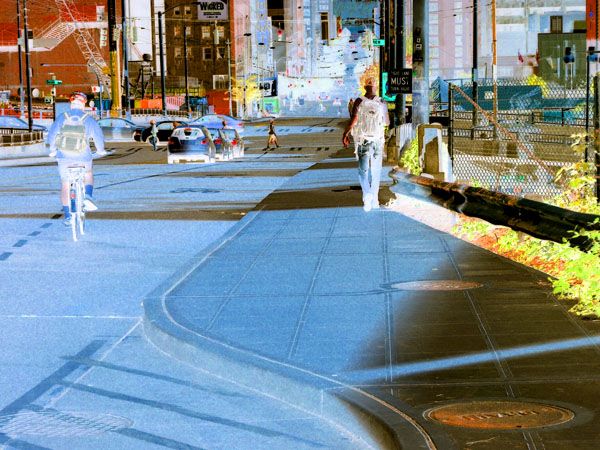
Most Seattle sidewalks are not photogenic. But to some of us, they are exciting nonetheless. The sidewalk in the photo above didn’t exist a few months ago. Back then, if you wanted to walk on Pine Street between one of the city’s most densely populated neighborhoods and downtown, you could only cross I-5 on the south side of the overpass.
Call it sidewalk creep. SDOT is quietly making it happen all over the city, your tax dollars at work via the 2006 Bridging the Gap levy.  As we chip away incrementally, some year we’ll wake up to a walkable city. And that’s some damn fine sustainable urbanism mojo.

Here’s another beauty completed a couple years ago on Union Street, one leg of a fairly pedestrian unfriendly six-way intersection between Union, Madison, and 12th on Capitol Hill.  That puppy is 16 feet wide (each scored square is 2 x 2 feet). A curb bulb was also installed on the other side of Union, creating a comfortably narrow pedestrian crossing.
Now that the City Council has approved the Pedestrian Master Plan, we should expect to see even more hot sidewalk action in the future. Well, probably. Sidewalks ain’t cheap—typical cost is about $2 million per mile, or about $100,000 per city block face.   So far the city has committed to spending $15 million per year on the Ped Master Plan.Â
The total cost of impementing everything in the Ped Master plan is in the range of $900 million. Did somebody say “priorities?”

[ Park(ing) Day on 1st Ave between University and Seneca ]
Yes, Park(ing) Day is the purest of wholesome urban goodness.  Last Friday in Seattle and cities all over the country, people took over street parking spaces, filled them with stuff, and hung out in publicly owned space that is normally and unquestionably surrendered for the storage of cars.
I had lunch out on a sod covered spot near the man-who-is-not-currently-hammering, and before long was joined by three friends who happened to be walking by checking out the scene. As Lewis Mumford put it, “The city is a place for multiplying happy chances and making the most of unplannable opportunities.” And creative use of our public spaces is one of the most powerful catalysts.
Yet there is also a lame subtext to Park(ing) Day in Seattle: It is officially sanctioned, but only allowed during a specific designated time window during a single designated day of the year. If you try it on any other day, you will be told to pack it up and leave by the Seattle Police Department, and you take the chance of being issued a ticket. Even if you put money in the meter to pay for your parking space.  Because you have to have an event permit, or some such nonsense. Not so in San Francisco, though Seattle is certainly not unique among municipalities in its curmugeonry.
That sort of overbearing regulation is begging to be challenged. Picture a renegade Park(ing) Day family dinner, complete with small children, a baby in a high chair. And then picture how stupid the cops would look trying to break it up. Park(ing) Day happenings should be allowed, if not encouraged to happen spontaneously on any and every day. Why the hell not?
>>>
Bonus:Â who can spot the eco-rock star in the photo?
The only question is why hasn’t anyone else in Seattle done this before now. Or have they? Such a seemingly obvious combination of two classic foods, loved by hipster and red-stater alike.  Â
Whether or not they’re first to market with the bacon cupcake, Seattle Coffee Works—on Pike between 1st and 2nd—has them today. I ate one. It was forced on me. I liked it.Â
Seattle Coffee Works is experimenting with all kinds of new cupcake varieties, and plans a free coffee and cupcake day in the near future to launch the new cupcake line.  Bad timing?  Here’s to hoping they can withstand the cupcake bubble, because they still make the consistently best cup of espresso in downtown Seattle.

Over the past week, the McGinn campaign:
Over the past week, the Mallahan campaign:
And both participated in a debate sponsored by the Queen Ann Chamber of Commerce.
I hope my faith in google has not distorted the picture here, but I don’t see how I could possibly have missed enough Mallahan action to significantly alter the imbalance revealed above.
Such a weird mayor’s race. McGinn is all hustle, while Mallahan appears to believe that all he has to do is be a warm body for business and labor. So far neither campaign has been very successful at garnering donations from Seattle residents. Mallahan has provided $232,000 of his campaign’s total $416,000, and recently said he will not contribute any more of his personal funds. Meanwhile, McGinn continues to operate an all volunteer campaign, and total funds raised just crossed the $100,000 mark last month.
My unapologetically biased take on things at this point: It’s hard not to conclude that Mallahan’s best hope is that enough people will be so afraid of the prospect of a world without a deep-bore tunnel that they will overlook his embarrassing lack of civic experience. Conversely, McGinn’s best hope is that his solid qualifications and progressive vision will not be overshadowed by a populace unwilling to face the urban transformations the future will inevitably demand.

Author Paul Hawken has a word for people who can’t shut up about how the whole world is going to hell: doomers. But during his keynote address to the Sustainable Industries Economic Forum in downtown Seattle on Thursday, he spoke in defense of them. Because doomers play a key role: they make designers do a better job. To effectively respond, designers need to know the true state of reality, no matter how grim. And in this context designer is a broad term including people who run businesses, make policy, and otherwise influence the trajectory of society.
Hawken is an inspiring speaker, with a graceful balance of data, humor, and soul. The overarching theme in his talk was the massive change coming with the inevitable rise in the cost of energy caused by peak oil. But overall, his message was positive: We have the potential to take on these formidable challenges, do more with less and create a better world: Now is not the best it will ever be.
For no rational reason, I was given the opportunity to interview Hawken after he spoke (note to aspiring bloggers: go with a potty-mouthed blog name).  When I brought up Kunstler’s book The Long Emergency, Hawken asked me to name the underlying premise of the book, and after making a couple obvious guesses, I was stumped. “People are punks,” was Hawken’s answer. And it’s so true. Kunstler’s doomsday scenarios rest on the assumption that human nature will fail in the face of our imminent transformational crises. I think it’s safe to conclude that Hawken finds this outlook deeply offensive.
In the context of urbanism, one of the most significant changes Hawken anticipates is localization. As the cost of transporting raw materials and finished goods rises, eventually the economic equation tilts in favor of local production. In which case the large tracts of industrial land just south of downtown Seattle become all the more valuable an asset. And as personal transport becomes more expensive, people live their lives in a smaller spatial sphere. In which case, compact communities with access to high quality transit become all the more valuable an an asset. In short, “location efficiency” matters.
But what doesn’t show up on the economic balance sheet for localization are the potential social benefits. When people are more locally focused, they tend to form more meaningful bonds with their neighbors and the place in which they live. And compared to mega-corporate absentee owners, local business owners are almost always more responsible toward their local communities. This is how, when the full spectrum of life is considered, we get more from less.
Hawken concluded his talk noting that there is no road map for where we are headed, and that all we really have to guide us is compassion for our fellow human beings. And he proceeded to receive a standing ovation from the packed room of 300 people from the Seattle-area green business community.

(Editor’s note:Â The following is a letter from Cary Moon to friends and supporters of PWC, reproduced here with permission.)
>>>
Dear friends,
It’s been a while since I wrote to share news with PWC friends and supporters. The politics around this viaduct decision were already tricky, and continue to get weirder. Here’s a recap from my perspective, to reestablish some facts and assess the next steps:
In December 2008, at the conclusion of an exhaustive and excellent stakeholder process, the three Departments of Transportion (DOTs) recommended either Surface /Transit / I-5 or the elevated as two viable options for viaduct replacement. Both solutions met the criteria for affordability, public safety, and mobility for people and freight, and the Surface/ Transit / I-5 plan fared better on the three other goals. (Remember –even tested against the worse case of regional car trips increasing 20% by 2015, modeling showed the Surface / Transit/ I-5 solution works great.) At that time, significant consensus among Seattle decision leaders was emerging around doing Surface / Transit / I-5 now, with continued study of also doing a single-bore tunnel.
By January 2009, the political playing field shifted, and the Governor, KC Executive, and Mayor announced a different decision: the State uses their money to dig a bored tunnel and help pay for the new Alaskan Way surface street, and the City and County do a scaled-back set of the proposed transit and street improvements with other money the State would help secure. The state legislature recommitted the state’s $2.8 billion to their part of this deal in March, called it final, and WSDOT is moving ahead.
It’s worth noting that officially, the State’s bored tunnel proposal is not a done deal, since a) WSDOT is not supposed to start a project before completing an EIS where the costs, risks, and environmental impacts are made public, and b) it isn’t fully funded. The County’s transit improvements– which would have been funded with $190 million in new Motor Vehicle Excise Tax – fell through when the 2009 legislature did not grant authority for King County to raise MVET fees. The City’s projects—streets improvements, the seawall, utility relocation, and transit enhancements ($930 million total, all good and necessary projects) – are moving forward with varying degrees of certainty and funding.
Many reasonable people like this compromise, are relieved the arguing is over, and are happy the waterfront is back safely in Seattle’s hands (29%- 49% of Seattleites, depending on how the question is asked). Many reasonable people don’t like this compromise (43% to 64%), and think that the bored tunnel is too risky, doesn’t fit Seattle’s future, goes against our City and State’s mandate to reduce Vehicle Miles Traveled (VMT), and is too expensive given other unfunded priorities. Some of these tunnel opponents like surface /transit /I-5, and some like the elevated.
This fall, Seattle is in the midst of a Mayoral election where the tunnel is a key issue. We’ve heard a lot of arguing over the decision that happened 9 months ago. At this point, it would be really helpful to know how the new Mayor will move forward from here. Here are some key questions we should all be asking both candidates:
1. Mobility within Seattle, with or without the State’s proposed bypass tunnel, will depend on well-connected streets, expanded transit service, better bike facilities, and a new surface Alaskan Way after the viaduct is removed. The recent stakeholder process thoroughly examined the local transportation system, and proposed a set of projects to improve mobility. What street and transit projects are in your plan for Seattle, and how will you fund them?
2. The EIS for the State’s proposed tunnel is underway, and will reveal crucial information about the tunnel’s cost, risk of overruns, constructability, effects on Seattle’s urban fabric, and environmental impacts. Other alternatives are not being considered in the EIS, and neither are the broadly supported I-5 improvements. What information do you expect to come out of the EIS? What will you do as Mayor if the tunnel’s cost escalates, if the risks are too high, or the environmental impacts are excessively harmful?
3. Even though the viaduct is primarily used for short in-city travel (85% of trips), the State holds a lot of power in this decision, and gets to decide what they do with their $2.8 billion. Whether you stop the tunnel (McGinn) or if the tunnel becomes infeasible (Mallahan), what is your alternative? How will you work with the State and regional players to fund your alternative and ensure it serves Seattle’s mobility needs well, removes the unsafe viaduct structure in a timely schedule, helps reduce VMT long-term, and redevelops the waterfront with the future of the city – and not just cars – in mind?
4. The State legislature added a provision to the tunnel funding bill requiring a handful of unsuspecting Seattle citizens to pay any cost overruns WSDOT or their contractors might incur. This betrayal of public trust is absurd, and probably illegal. Do you think this is unfair, and how would you remove it?
5. When the viaduct is torn down, our generation gets to reweave the urban fabric and connect future Seattle to the waters of Puget Sound. How will you lead the effort to make a magnificent place, where the new street, the seawall and beaches, new parks, pedestrian and bike paths, and bordering properties all function beautifully together as the civic heart of Seattle?
This is not the only issue, of course, but it may be the most complex challenge / opportunity our next Mayor will face.
The People’s Waterfront Coalition is currently working hard with our allies on three things:
– organizing the waterfront planning framework so the waterfront unfolds to its most brilliant potential,
– helping define smarter goals and more innovative ideas for the seawall project, and
– helping build political momentum for more sustainable funding for bus transit.
More soon on those topics.
— Cary Moon